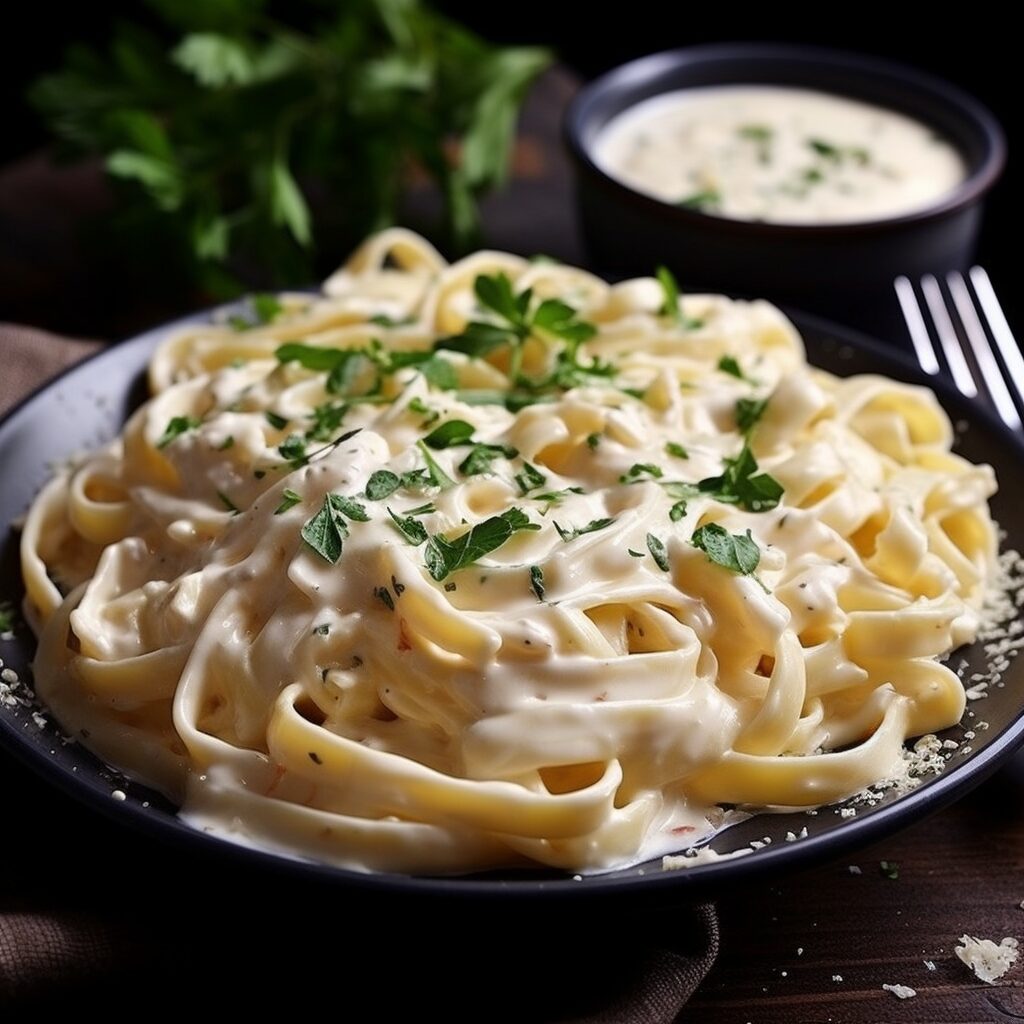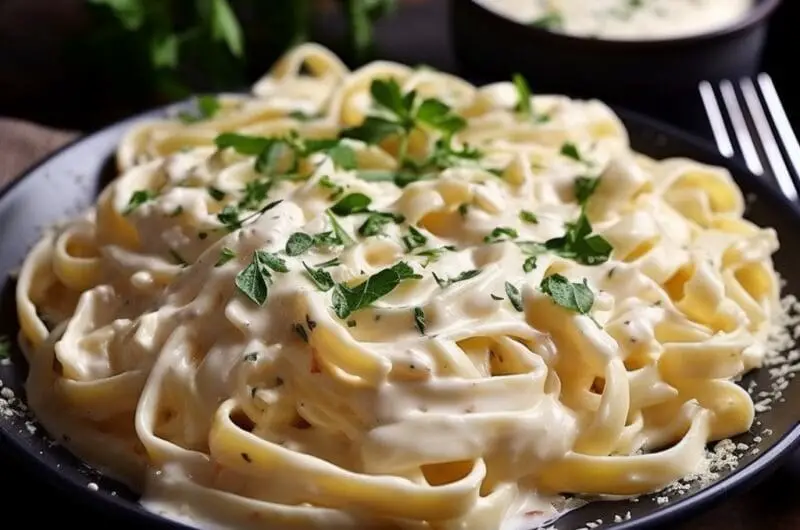Olive Garden’s Alfredo sauce has been a beloved staple on the restaurant’s menu since its founding in 1982. This rich and creamy sauce, paired with fettuccine pasta and your choice of chicken or seafood, has become a favorite among pasta enthusiasts. Let’s dive into the history and composition of this iconic sauce and explore how you can recreate this Olive Garden classic at home.
The Origins of Olive Garden’s Alfredo Sauce
Alfredo sauce, as we know it today, is an American adaptation of the Italian pasta dish “fettuccine al burro,” which translates to fettuccine with butter. The original dish, created by Alfredo di Lelio in Rome during the early 20th century, consisted of just three ingredients: fettuccine pasta, butter, and Parmesan cheese.
When Hollywood celebrities Mary Pickford and Douglas Fairbanks visited Alfredo’s restaurant in Rome and fell in love with the dish, they helped popularize it in the United States. As the dish gained popularity, American chefs began adding heavy cream to the sauce, creating the rich and creamy Alfredo sauce we know today.
Olive Garden’s version of Alfredo sauce has remained largely unchanged since the restaurant’s opening, showcasing the timeless appeal of this classic dish. The sauce’s popularity has made Chicken Alfredo the most ordered item on the Olive Garden menu.
Tip: For an authentic Italian dining experience at home, serve your Alfredo sauce over fresh, homemade fettuccine pasta. Pair it with a crisp white wine and a side salad for a complete meal.
To make your own fresh pasta at home, consider investing in a high-quality pasta maker like the Marcato Atlas 150 Pasta Machine. This classic manual pasta maker is made in Italy and allows you to easily create fresh fettuccine, spaghetti, and lasagna sheets at home.
Key Ingredients in Olive Garden’s Alfredo Sauce
Olive Garden’s Alfredo sauce recipe includes a combination of butter, heavy cream, milk, garlic, flour, and imported Parmesan and Romano cheeses. The garlic is a key component, with a generous amount of one tablespoon or three to four minced cloves used in the sauce.
The flour acts as a thickening agent, helping to create the sauce’s signature smooth and creamy texture. The combination of Parmesan and Romano cheeses adds a sharp, salty flavor that complements the richness of the butter and cream.
When recreating Olive Garden’s Alfredo sauce at home, it’s essential to use high-quality ingredients. Opt for fresh, minced garlic, and be sure to use freshly grated Parmesan and Romano cheeses for the best flavor and texture.
Tip: For an even creamier sauce, try using a combination of heavy cream and half-and-half instead of milk.
To easily grate your own Parmesan and Romano cheeses at home, consider using a versatile kitchen tool like the Microplane Premium Classic Series Zester Grater. This durable, razor-sharp grater is perfect for grating hard cheeses, as well as zesting citrus fruits and grating nutmeg and ginger.
Pairing Suggestions and Serving Tips
Olive Garden recommends pairing their Alfredo sauce with fettuccine pasta, as the broad, flat shape of the noodles allows the thick sauce to cling better. The sauce also pairs well with both chicken and seafood, as the lightness of the meat complements the richness of the sauce.
When serving Alfredo sauce, Olive Garden encourages guests to add extra Parmesan cheese on top, stating that “you can never have enough Parmesan.” This additional sprinkle of cheese enhances the flavor and texture of the dish, making it even more irresistible.
If you’re looking for a healthier twist on Alfredo sauce, try using whole wheat fettuccine or even zucchini noodles as your base. You can also experiment with adding vegetables like broccoli or peas to your Alfredo for an extra boost of nutrition.
Tip: To reheat leftover Alfredo sauce, add a splash of milk or cream to help loosen the sauce and prevent it from separating.
When reheating your Alfredo sauce, be sure to use a high-quality saucepan to ensure even heating and prevent scorching. The All-Clad D3 Stainless Steel Sauce Pan is a great choice, as its tri-ply construction promotes even heat distribution and prevents hot spots.
In conclusion, Olive Garden’s Alfredo sauce has stood the test of time, remaining a beloved classic on the restaurant’s menu for nearly four decades. By using high-quality ingredients and following the restaurant’s signature recipe, you can easily recreate this creamy, cheesy sauce at home. Whether you’re serving it over fettuccine, pairing it with chicken or seafood, or experimenting with healthier variations, Olive Garden’s Alfredo sauce is sure to delight your taste buds and transport you to the heart of Italy with every bite.
Olive Garden Alfredo Sauce
Course: Main CourseCuisine: Italian4
servings10
minutes20
minutes450
kcalRecreate the iconic taste of Olive Garden’s Alfredo sauce at home with this easy recipe. Creamy, cheesy, and bursting with flavor, this sauce is perfect for pasta, chicken, and more!
Ingredients
1/2 cup butter
3-4 cloves garlic, minced
2 tablespoons all-purpose flour
1 1/2 cups heavy cream
1/2 cup milk
1 cup freshly grated Parmesan cheese
1/2 cup freshly grated Romano cheese
Salt and black pepper, to taste
Freshly grated nutmeg, to taste (optional)
Directions
- In a large saucepan, melt the butter over medium heat. Add the minced garlic and sauté for 1-2 minutes until fragrant, being careful not to burn the garlic.
- Whisk in the flour and cook for 1-2 minutes, stirring constantly, to remove the raw flour taste. The mixture should be smooth and bubbly.
- Gradually whisk in the heavy cream and milk, stirring continuously to prevent lumps from forming. Bring the mixture to a gentle simmer, stirring occasionally.
- Reduce the heat to low and add the grated Parmesan and Romano cheeses. Stir until the cheeses have melted and the sauce is smooth.
- Season the sauce with salt, black pepper, and a pinch of freshly grated nutmeg (if desired). Taste and adjust the seasoning as needed.
- Simmer the sauce for an additional 5-10 minutes, stirring occasionally, until it reaches your desired consistency. If the sauce becomes too thick, add a splash of milk or cream to thin it out.
- Serve the Alfredo sauce hot over your favorite pasta, such as fettuccine. Garnish with additional grated Parmesan cheese and freshly chopped parsley, if desired.
- Store any leftover sauce in an airtight container in the refrigerator for up to 3 days. Reheat gently on the stovetop, adding a splash of milk or cream if needed to restore the creamy consistency.
Notes
- For best results, use freshly grated Parmesan and Romano cheeses. Pre-shredded cheeses may not melt as smoothly due to added anti-caking agents.
- Adjust the garlic to your taste preferences. Olive Garden uses a generous amount, but you can use less if you prefer a milder garlic flavor.
- This sauce can be paired with grilled chicken, shrimp, or vegetables for a complete meal.
Frequently Asked Questions
Q: Can I use milk instead of heavy cream?
A: While you can use milk, the sauce will be thinner and less rich. For the authentic Olive Garden taste and texture, it’s best to use heavy cream.
Q: Can I make this sauce ahead of time?
A: Yes, you can prepare the sauce in advance and store it in the refrigerator for up to 3 days. Reheat it gently on the stovetop, stirring occasionally and adding a splash of milk or cream if needed.
Q: Is it necessary to use both Parmesan and Romano cheeses?
A: Using both cheeses gives the sauce a more complex flavor, but you can use just Parmesan if you don’t have Romano on hand.
Q: Can I freeze Alfredo sauce?
A: While it’s possible to freeze Alfredo sauce, it may separate and become grainy when thawed. It’s best to make the sauce fresh or store it in the refrigerator for up to 3 days.


